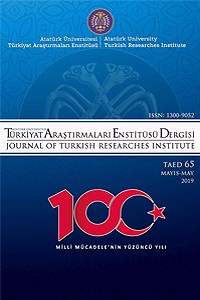Abstract
Divan şiiri, özellikle 19.yüzyılda Osmanlı coğrafyasındaki tüm bölgelerde kalem ehli arasında oldukça yayılmış; saray edebiyatı tanımının aksine devlet memurları, ordu mensupları, medrese ve tarikat erbabı gibi toplumun okumuş kesiminin önemli bir kısmını etkilemiştir. Tezkirelerde ve edebiyat tarihlerinde bu asırdaki şairlerin sayı olarak tüm zamanlardan fazla olması, bu kuvvetli geleneğin son yüzyıla büyük bir birikim ile girdiğini göstermektedir.
Özellikle tarikatlar, dinî ve tasavvufî misyonlarının yanında edebî faaliyetlerin merkezlerinden biri olarak da mevcudiyetlerini sürdürmüştür. Halvetîlik, Nakşibendîlik gibi yaygın tarikatlar aynı zamanda Anadolu’nun en uzak bölgelerinde dahi divan şiiri geleneğini yaşatmış, şairlerin yetiştiği birer kuruma dönüşmüştür.
Bu çalışmada 19. yüzyılda Erzurum ve çevresinde tasavvufi kimliği ile şöhret bulmuş Şeyh Ziyâeddin Taşkesenî’nin hayatı ele alınmış; bir mecmuada tespit edilen klasik tarzdaki şiirleri Latin harflerine aktarılarak metinler şekil, muhteva, dil ve üslup bakımından detaylı bir şekilde incelenmiştir. Böylece mutasavvıf bir şahsiyet olmakla birlikte gazellerini tamamen klasik şiir geleneği çerçevesinde kaleme alan Ziyâeddin Taşkesenî’nin edebî kişiliği ve şiirleri de edebiyat dünyasına tanıtılacaktır.
References
- Ak, Coşkun (1987). Muhibbî Divanı. Ankara: Kültür ve Turizm Bakanlığı Yayınları. Algar, Hamit (2006). “Nakşibendiyye”. Türkiye Diyanet Vakfı İslam Ansiklopedisi, (XXXII, 335-342). İstanbul: Türkiye Diyanet Vakfı Yayınları. Apak, İlhan (Ed.). (1993). Evliyalar Ansiklopedisi. Cilt 11. İstanbul: Türkiye Gazetesi Yayınları. Aras, M. Sıtkı (2007). Erzurum’un Manevi Mimarları. İstanbul: Dergâh Yayınları. Kasır, Hasan Ali (1997). Erzurum Şiirleri Antolojisi. Erzurum: Ervak Yayınları. Mermer, Ahmet (1991). Mezâkî Hayatı, Edebî Kişiliği ve Divanı’nın Tenkitli Metni. Ankara: Atatürk Kültür Merkezi Yayınları. Öngören, Reşat (2015). “Osmanlı Türkiye’sinde Tarikatlar”. Ed. Semih Ceyhan, Türkiye’de Tarikatlar Tarih ve Kültür (ss. 55-94) içinde. İstanbul: İSAM Yayınları. Ören, Mücahit (Ed.). (2004). Doğu Anadolu Evliyaları. Cilt 1. İstanbul: Türkiye Gazetesi Yayınları. Parlatır, İsmail (2014). Fuzulî Türkçe Divan. Ankara: Akçağ Yayınları. Saraç, Yekta (2013). Klasik Edebiyat Bilgisi Biçim-Ölçü-Kafiye. İstanbul: Gökkubbe Yayınları. Taşkesenligil, Fuat (2002). Silsile-i Âliye’nin Taşkesenli Halkası. Erzurum: Bakanlar Matbaacılık. Taşkesenligil, İbrahim (2011). “Taşkesenli”. Türkiye Diyanet Vakfı İslam Ansiklopedisi, (XL,148). İstanbul: Türkiye Diyanet Vakfı Yayınları. Tosun, Necdet (2015). “Nakşibendiyye”. Ed. Semih Ceyhan, Türkiye’de Tarikatlar Tarih ve Kültür (ss. 691-694) içinde. İstanbul: İSAM Yayınları.
Abstract
Divan poetry
spread considerably among the writing experts, especially in all the regions of
the Ottoman geography in the 19th century; contrary to the
definition of palace literature, it affected a significant part of the educated
section of the society such as civil servants, members of the army, madrasa and
religious order experts. The fact that the number of poets in this century in
the tezkires and in the sources of literary is more than ever; history shows
that this strong tradition entered into the last century with a great
accumulation.
In particular,
religious orders continued to exist as one of the centers of literary activities
besides their religious and mystical missions. At the same time, widespread
religious orders such as Halvetism and Naqshbandi sustained the tradition of
divan poetry even in the farthest regions of Anatolia, and became an
institution where the poets trained.
In this study, the life of Şeyh Ziyâeddin Taşkesenî,
who became famous with his mystic identity in Erzurum and its surroundings in
the 19th century, was discussed; his poems of the classical style detected in a
magazine were studied in detail in terms of form, content, language and style
by transferring them to Latin letters. Thus, the literary personality and poems
of Ziyâeddin Taşkesenî, who had a sufistic personality and committed his gazels
to paper completely in the frame of classical poetry tradition, will also be
introduced to the world of literature.
References
- Ak, Coşkun (1987). Muhibbî Divanı. Ankara: Kültür ve Turizm Bakanlığı Yayınları. Algar, Hamit (2006). “Nakşibendiyye”. Türkiye Diyanet Vakfı İslam Ansiklopedisi, (XXXII, 335-342). İstanbul: Türkiye Diyanet Vakfı Yayınları. Apak, İlhan (Ed.). (1993). Evliyalar Ansiklopedisi. Cilt 11. İstanbul: Türkiye Gazetesi Yayınları. Aras, M. Sıtkı (2007). Erzurum’un Manevi Mimarları. İstanbul: Dergâh Yayınları. Kasır, Hasan Ali (1997). Erzurum Şiirleri Antolojisi. Erzurum: Ervak Yayınları. Mermer, Ahmet (1991). Mezâkî Hayatı, Edebî Kişiliği ve Divanı’nın Tenkitli Metni. Ankara: Atatürk Kültür Merkezi Yayınları. Öngören, Reşat (2015). “Osmanlı Türkiye’sinde Tarikatlar”. Ed. Semih Ceyhan, Türkiye’de Tarikatlar Tarih ve Kültür (ss. 55-94) içinde. İstanbul: İSAM Yayınları. Ören, Mücahit (Ed.). (2004). Doğu Anadolu Evliyaları. Cilt 1. İstanbul: Türkiye Gazetesi Yayınları. Parlatır, İsmail (2014). Fuzulî Türkçe Divan. Ankara: Akçağ Yayınları. Saraç, Yekta (2013). Klasik Edebiyat Bilgisi Biçim-Ölçü-Kafiye. İstanbul: Gökkubbe Yayınları. Taşkesenligil, Fuat (2002). Silsile-i Âliye’nin Taşkesenli Halkası. Erzurum: Bakanlar Matbaacılık. Taşkesenligil, İbrahim (2011). “Taşkesenli”. Türkiye Diyanet Vakfı İslam Ansiklopedisi, (XL,148). İstanbul: Türkiye Diyanet Vakfı Yayınları. Tosun, Necdet (2015). “Nakşibendiyye”. Ed. Semih Ceyhan, Türkiye’de Tarikatlar Tarih ve Kültür (ss. 691-694) içinde. İstanbul: İSAM Yayınları.
Details
| Primary Language | Turkish |
|---|---|
| Journal Section | Makaleler |
| Authors | |
| Publication Date | May 31, 2019 |
| Published in Issue | Year 2019 Issue: 65 |


